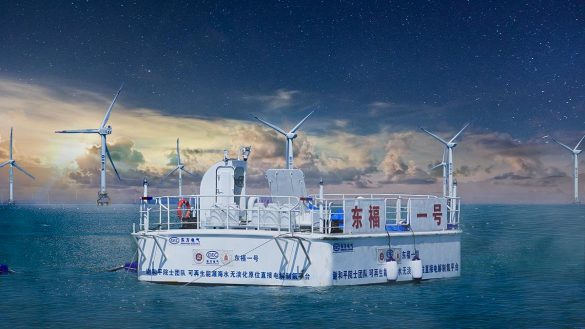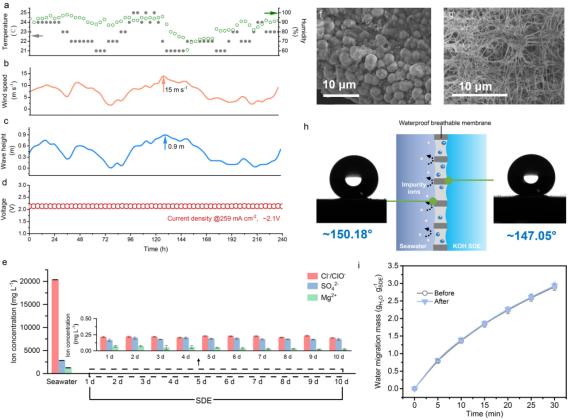On June 21, 2024, Academician Xie Heping and his team from Shenzhen University (SZU) published their research entitled "In-situ direct seawater electrolysis using floating platform in ocean with uncontrollable wave motion" inNature Communications. Building upon their new principle and technology of direct seawater electrolysis for hydrogen production based on phase transition migration, which was published in Nature on November 30, 2022, the research addresses the scientific challenges and engineering gaps posed by realizing direct hydrogen production from seawater in the real ocean, such as the wave motion due to the complex conditions of seawater multi-field coupling, and proposes a new path and technology for direct hydrogen production from seawater without being affected by uncontrollable wave motion in the real ocean.

Figure 1: Research on the direct seawater electrolysis for hydrogen production based on phase transition migration in wave motion
Academician Xie's team and Dongfang Electric Corporation have jointly designed and developed a 1.2 Nm3/h offshore renewable energy floating platform which applies to desalination-free in-situ direct seawater electrolysis for hydrogen production. The platform successfully achieved its first direct integration with offshore wind power in Xinghua Bay, Fujian Province, under wind conditions ranging from force 3-8 and wave heights of 0.3-0.9m. It operated continuously and steadily for 10 days, achieving a seawater impurity ion rejection rate of over 99.99% and hydrogen purity ranging from 99.9% to 99.99%. This marks the first construction of a novel integrated model combining direct seawater electrolysis with renewable energy sources, paving the way for a new global frontier in direct seawater electrolysis for hydrogen production from offshore renewable energy sources.

Figure 2: The world's first sea trial success of offshore wind-powered desalination-free in-situ direct seawater electrolysis for hydrogen production

Figure 3: Reliability and stability of direct seawater electrolysis for hydrogen production in real ocean (Xinghua Bay, Fujian Province)
This research represents a solid stride forward in the industrialization of a novel principle technology for desalination-free in-situ direct seawater electrolysis for hydrogen production. The widespread application of this technology is poised to pioneer a new marine green hydrogen industry system integrating utilization of offshore wind and other renewable energy sources, seawater resource utilization, and hydrogen production. It is expected to establish a new model of in-situ seawater electrolysis for hydrogen production, with no need for desalination, additional catalytic engineering, seawater transport, or pollution treatment, thereby truly transforming inexhaustible "seawater resources" into "seawater energy". Furthermore, this technology holds promise for establishing integrated in-situ seawater hydrogen production facilities combined with offshore renewable energy, crucially enabling large-scale development of renewable electricity in nearshore and offshore regions. It accelerates the establishment of China's original "marine green hydrogen" as a global emerging strategic industry, promoting synergistic energy diversification. It also supports the full-chain development of marine green hydrogen, from original principles and disruptive technologies to domestically produced equipment and distinctive electrolytic hydrogen industrial models. This holistic approach from China offers solutions, wisdom, and standards for zero-carbon energy in the path towards carbon neutrality.
Link: https://www.nature.com/articles/s41467-024-49639-6

